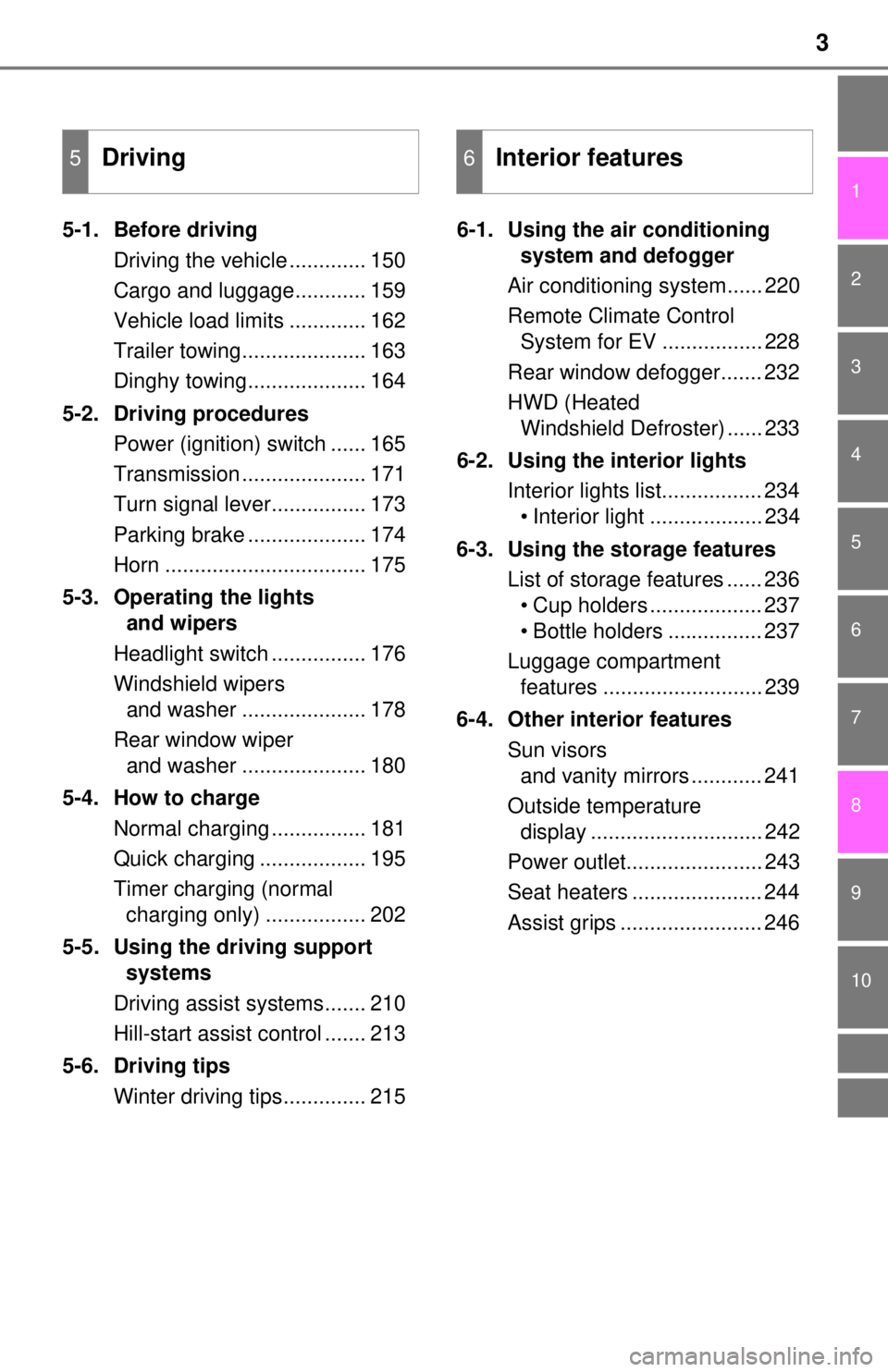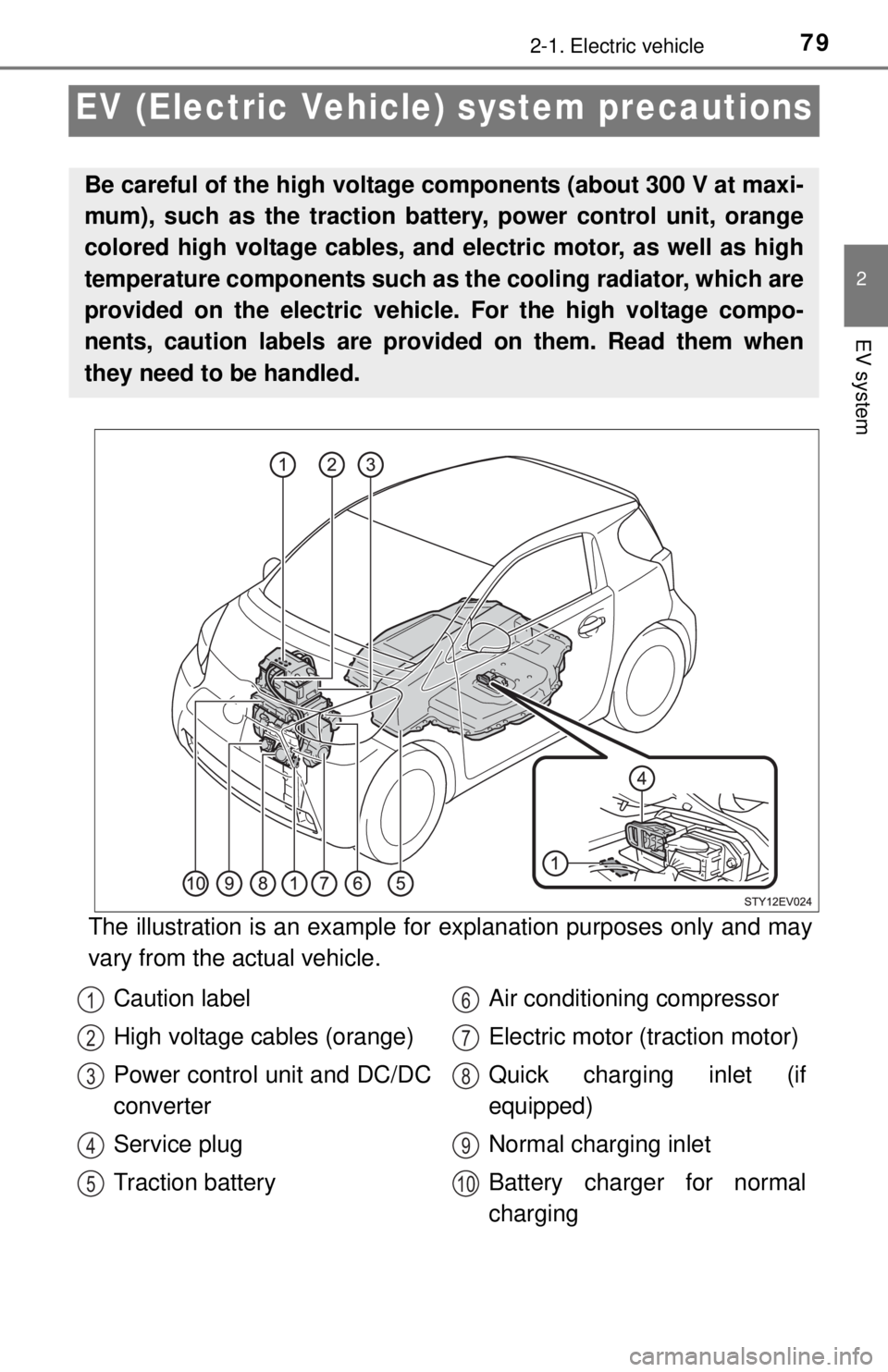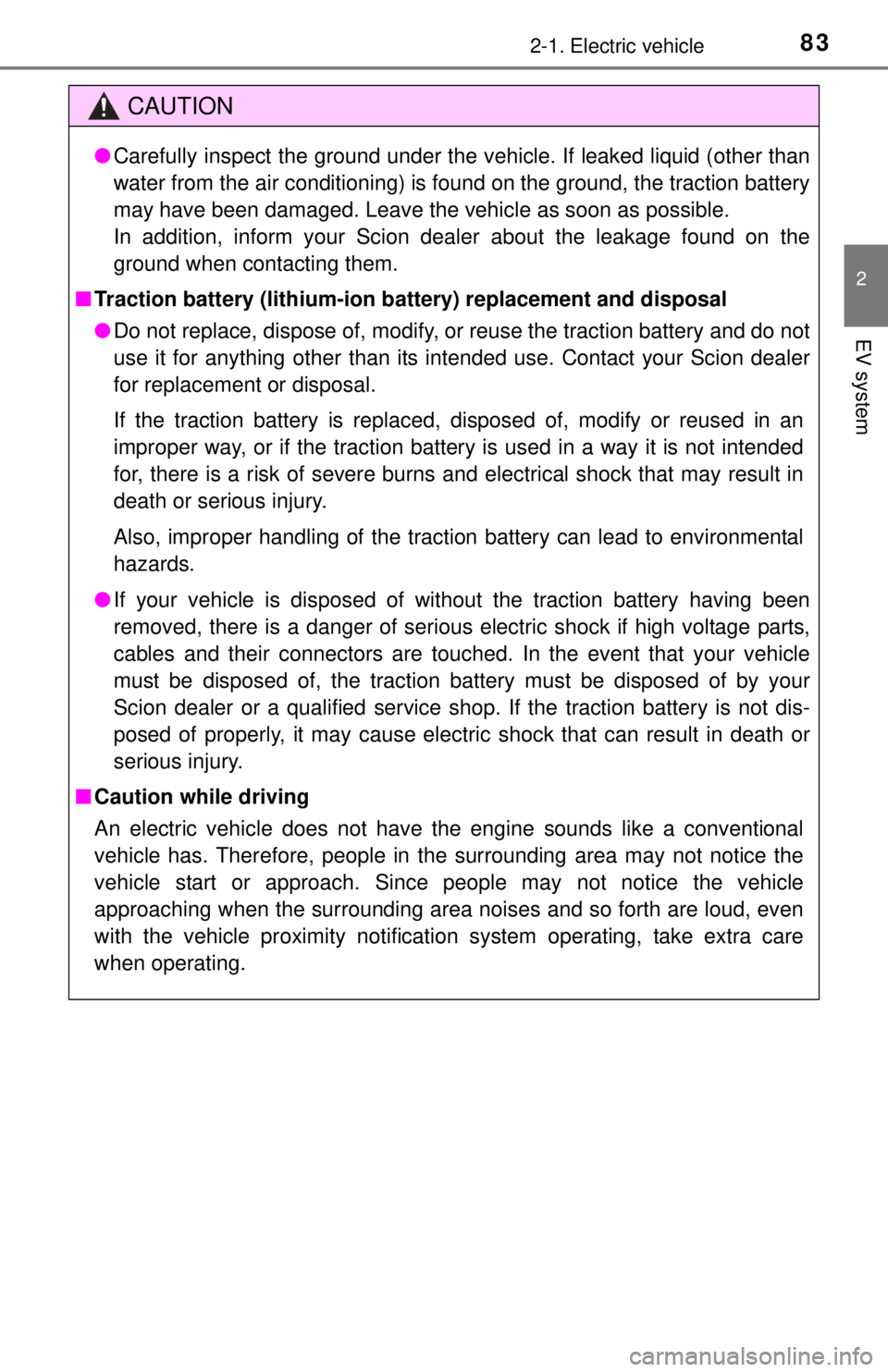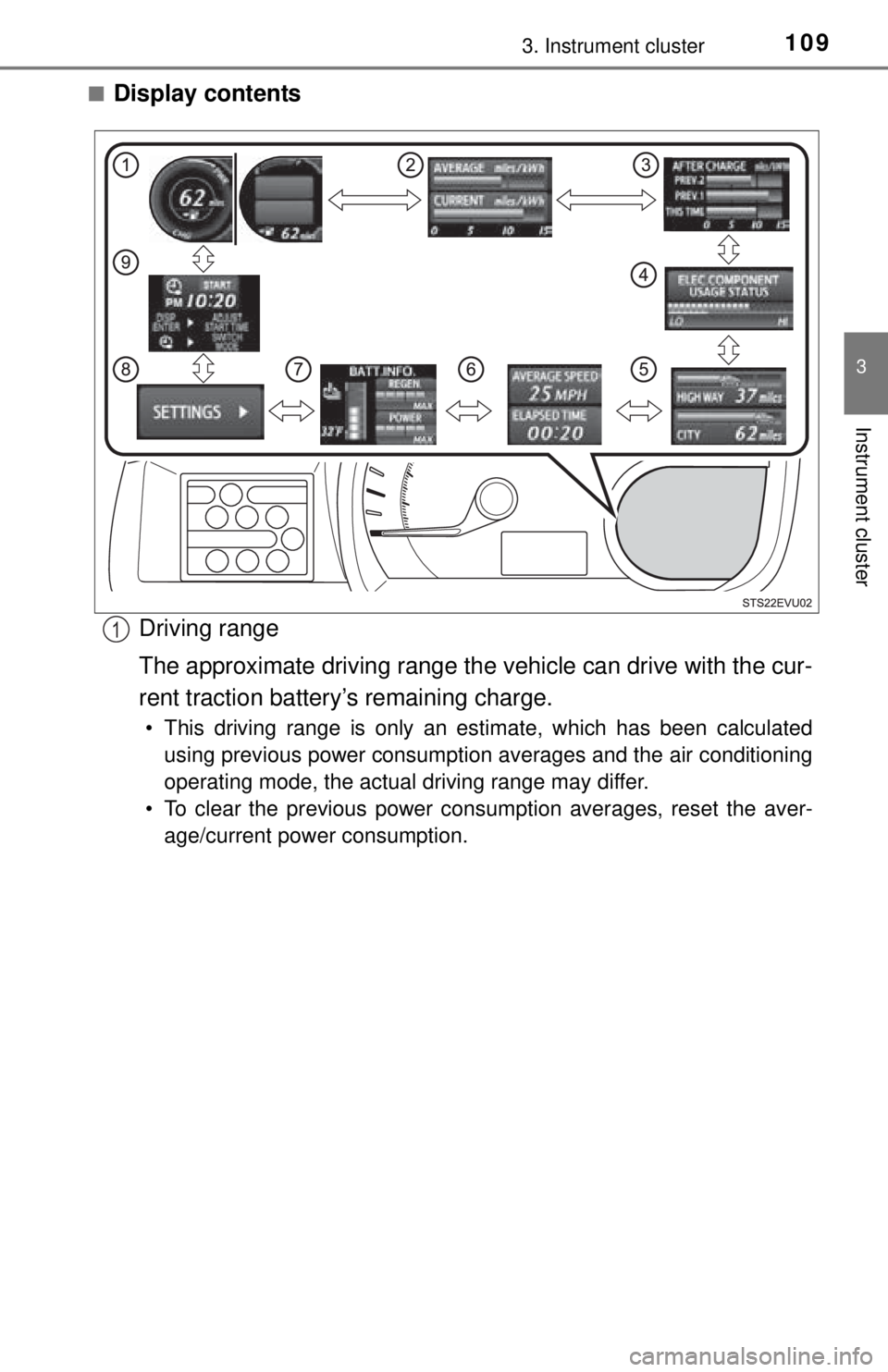air conditioning TOYOTA iQ EV 2013 Owners Manual (in English)
[x] Cancel search | Manufacturer: TOYOTA, Model Year: 2013, Model line: iQ EV, Model: TOYOTA iQ EV 2013Pages: 444, PDF Size: 7.34 MB
Page 3 of 444

3
9 8
7
6
5
4
3
10
1
2
5-1. Before drivingDriving the vehicle ............. 150
Cargo and luggage............ 159
Vehicle load limits ............. 162
Trailer towing..................... 163
Dinghy towing.................... 164
5-2. Driving procedures Power (ignition) switch ...... 165
Transmission ..................... 171
Turn signal lever................ 173
Parking brake .................... 174
Horn .................................. 175
5-3. Operating the lights and wipers
Headlight switch ................ 176
Windshield wipers and washer ..................... 178
Rear window wiper and washer ..................... 180
5-4. How to charge Normal charging ................ 181
Quick charging .................. 195
Timer charging (normal charging only) ................. 202
5-5. Using the driving support systems
Driving assist systems....... 210
Hill-start assist control ....... 213
5-6. Driving tips Winter driving tips.............. 215 6-1. Using the air conditioning
system and defogger
Air conditioning system...... 220
Remote Climate Control System for EV ................. 228
Rear window defogger....... 232
HWD (Heated Windshield Defroster) ...... 233
6-2. Using the interior lights Interior lights list................. 234• Interior light ................... 234
6-3. Using the storage features List of storage features ...... 236• Cup holders ................... 237
• Bottle holders ................ 237
Luggage compartment features ........................... 239
6-4. Other interior features Sun visors and vanity mirrors ............ 241
Outside temperature display ............................. 242
Power outlet....................... 243
Seat heaters ...................... 244
Assist grips ........................ 246
5Driving6Interior features
Page 4 of 444

TABLE OF CONTENTS4
7-1. Maintenance and careCleaning and protecting the vehicle exterior .......... 248
Cleaning and protecting the vehicle interior ........... 251
7-2. Maintenance Maintenance requirements ................... 254
General maintenance ........ 256
7-3. Do-it-yourself maintenance Do-it-yourself service precautions ..................... 260
Inspecting the charging cable ............................... 262
Hood.................................. 264
Positioning a floor jack ...... 266
Replacing the tire .............. 269
Motor compartment ........... 277
Tires .................................. 285
Tire inflation pressure........ 292
Wheels .............................. 295
Air conditioning filter .......... 297
Electronic key battery ........ 299
Checking and replacing fuses ............................... 301
Light bulbs ......................... 311 8-1. Essential information
Emergency flashers ........... 328
If your vehicle has to be stopped in an
emergency....................... 329
8-2. Steps to take in an emergency
If your vehicle needs to be towed ...................... 330
If you think something is wrong ......... 334
If a warning light turns on or a warning buzzer
sounds ............................. 335
If a warning message is displayed...................... 344
If you have a flat tire .......... 359
If the EV system will not start ................................. 375
If charging cannot be done ........................... 377
If the shift lever cannot be shifted from P ............. 383
If the electronic key does not operate properly ........ 384
If the 12-volt battery is discharged ................... 386
If your vehicle overheats.... 390
If the vehicle becomes stuck ................................ 393
7Maintenance and care8When trouble arises
Page 15 of 444

15Pictorial index
Multi-information display . . . . . . . . . . . . . . . . . . . . . . . . . . . P. 108
Display contents. . . . . . . . . . . . . . . . . . . . . . . . . . . . . . . . . . . . P. 108
Settings change . . . . . . . . . . . . . . . . . . . . . . . . . . . . . . . . . . . . P. 112
When the warning messages are displayed . . . . . . . . . . . . . . P. 344
Parking brake lever . . . . . . . . . . . . . . . . . . . . . . . . . . . . . . . . P. 174
Applying/releasing . . . . . . . . . . . . . . . . . . . . . . . . . . . . . . . . . . P. 174
Precautions against winter season . . . . . . . . . . . . . . . . . . . . . P. 216
Warning buzzer/message . . . . . . . . . . . . . . . . . . . . . . . . P. 335, 349
Turn signal lever . . . . . . . . . . . . . . . . . . . . . . . . . . . . . . . . . . P. 173
Headlight switch . . . . . . . . . . . . . . . . . . . . . . . . . . . . . . . . . . P. 176
Headlights/parking lights/tail lights . . . . . . . . . . . . . . . . . . . . . . P. 176
Wiper and washer switch . . . . . . . . . . . . . . . . . . . . . . . P. 178, 180
Usage (front) . . . . . . . . . . . . . . . . . . . . . . . . . . . . . . . . . . . . . . P. 178
Usage (rear) . . . . . . . . . . . . . . . . . . . . . . . . . . . . . . . . . . . . . . . P. 180
Adding washer fluid . . . . . . . . . . . . . . . . . . . . . . . . . . . . . . . . . P. 283
Emergency flasher switch . . . . . . . . . . . . . . . . . . . . . . . . . . P. 328
Hood lock release lever. . . . . . . . . . . . . . . . . . . . . . . . . . . . . P. 264
Tilt steering control lever . . . . . . . . . . . . . . . . . . . . . . . . . . . P. 143
Air conditioning system . . . . . . . . . . . . . . . . . . . . . . . . . . . . P. 220
Usage . . . . . . . . . . . . . . . . . . . . . . . . . . . . . . . . . . . . . . . . . . . P. 221
Remote Climate Control System for EV
*1. . . . . . . . . . . . . . . . P. 228
Navigation system
*2
*1: Referred to below as “Remote Climate Control”.
*2: Refer to the “Navigation System Owner’s Manual”.
4
5
6
7
8
9
10
11
12
Page 75 of 444

752-1. Electric vehicle
2
EV system
■Regenerative braking
In the following situations, kinetic energy is converted to electric energy and
deceleration force can be obtained in conjunction with the recharging of the
traction battery.
●The accelerator pedal is released while driving with the shift lever in D, S or
B.
● The brake pedal is depressed while driving with the shift lever in D, S or B.
If “REGENERATIVE BRAKING LIMITED” appears on the multi-information
display, refer to P. 347.
■ 12-volt battery recharging
The 12-volt battery is charged from the traction battery when the EV system
is operated or while the traction battery is being charged.
If the vehicle has not been used for a long time, the 12-volt battery may
become low due to self-discharge. If this occurs, follow the correct proce-
dures. ( P. 386)
■ When not using the vehicle for an extended period of time
P. 191
■ Charging the traction battery
Be sure to maintain the traction battery charge level suitable for your driving
needs.
If the traction battery fully discharges, the vehicle cannot be driven at all.
When the battery becomes low, charge it as soon as possible.
■ If the traction battery becomes low
●If the SOC (State of Charge) warning light flashes, the power used by the air
conditioning system will automatically be restricted and the traction battery’s
remaining charge will be distributed for driving the vehicle. If the traction bat-\
tery fully discharges, driving will not be possible. When the battery becomes
low, charge it as soon as possible.
Page 77 of 444

772-1. Electric vehicle
2
EV system
■Driving Range
■ Sound and vibrations speci fic to an electric vehicle
Because an electric vehicle does not have the engine sound or vibrations that
a conventional vehicle has, the driver may not notice that the “READY” indi-
cator is illuminated and the vehicle can be driven. For safety reasons, always
shift the shift lever to P and apply the parking brake when the vehicle is
parked.
Before and after the EV system is started, the following sounds and vibrations
may occur.
However, these sounds and/or vibrations are not signs of malfunctions:
● The brake system operation sound heard from the front of the vehicle when
the driver’s door is opened.
● Motor sounds coming from the motor compartment.
● Electrical relay sounds may be heard from the motor compartment when the
EV system starts or stops.
● Relay operating sounds such as a snap or soft clank will be emitted from the
traction battery in the following situations:
• When the EV system is started or stopped
• When charging starts or finishes
• When the vehicle is driven the first time after the traction battery has been
charged using quick charge
● Operating sounds or motor sounds that occur when the brake pedal is oper-
ated.
● Cooling fan operating sounds from the radiator and/or traction battery.
● The operation sound of the air conditioning system (air conditioning com-
pressor, blower motor).
An estimated possible driving range,
which is calculated from traction battery’s
remaining charge, the air conditioning
operating mode and so forth, is shown on
the multi-information display.
However, the actual possible driving
range significantly varies depending on
the driving manner, weather and usage of
electrical components.
Use the estimated possible driving range
as a reference only, and try to keep the
battery as charged as possible.
Page 79 of 444

792-1. Electric vehicle
2
EV system
EV (Electric Vehicle) system precautions
The illustration is an example for explanation purposes only and may
vary from the actual vehicle.
Be careful of the high voltage components (about 300 V at maxi-
mum), such as the traction battery, power control unit, orange
colored high voltage cables, and electric motor, as well as high
temperature components such as the cooling radiator, which are
provided on the electric vehicle. For the high voltage compo-
nents, caution labels are provided on them. Read them when
they need to be handled.
Caution label
High voltage cables (orange)
Power control unit and DC/DC
converter
Service plug
Traction battery Air conditioning compressor
Electric motor (traction motor)
Quick charging inlet (if
equipped)
Normal charging inlet
Battery charger for normal
charging1
2
3
4
5
6
7
8
9
10
Page 83 of 444

832-1. Electric vehicle
2
EV system
CAUTION
●Carefully inspect the ground under the vehicle. If leaked liquid (other than
water from the air conditioning) is found on the ground, the traction battery
may have been damaged. Leave the vehicle as soon as possible.
In addition, inform your Scion dealer about the leakage found on the
ground when contacting them.
■ Traction battery (lithium-ion ba ttery) replacement and disposal
● Do not replace, dispose of, modify, or reuse the traction battery and do not
use it for anything other than its intended use. Contact your Scion dealer
for replacement or disposal.
If the traction battery is replaced, disposed of, modify or reused in an
improper way, or if the traction battery is used in a way it is not intended
for, there is a risk of severe burns and electrical shock that may result in
death or serious injury.
Also, improper handling of the traction battery can lead to environmental
hazards.
● If your vehicle is disposed of without the traction battery having been
removed, there is a danger of serious electric shock if high voltage parts,
cables and their connectors are touched. In the event that your vehicle
must be disposed of, the traction battery must be disposed of by your
Scion dealer or a qualified service shop. If the traction battery is not dis-
posed of properly, it may cause electric shock that can result in death or
serious injury.
■ Caution while driving
An electric vehicle does not have the engine sounds like a conventional
vehicle has. Therefore, people in th e surrounding area may not notice the
vehicle start or approach. Since people may not notice the vehicle
approaching when the surrounding area noises and so forth are loud, even
with the vehicle proximity notification system operating, take extra care
when operating.
Page 97 of 444

972-3. Driving the EV (Electric Vehicle)
2
EV system
■Air conditioning on/off
●Switch the air conditioning off when it is not needed. Doing so
can help control excessive elec tricity and power consumption.
In summer:
In high temperatures, use the re circulated air mode. Doing so will
help to reduce the burden on the air conditioning and reduce
power consumption as well.
In winter:
Excessive or unnecessary heating should be avoided. The use of
the seat heater ( P. 244) is effective to avoid excessive power
consumption.
● For efficiency, use the Remote Climate Control before departing
while the charging cable is connected. ( P. 228)
■Checking tire inflation pressure
Make sure to check the tire infl ation pressure frequently. Improper
tire inflation pressure can cause poor power consumption.
Also, as snow tires can cause large amounts of friction, their use on
dry roads will lead to p oor power consumption. Use tires that are
appropriate for the season.
■Luggage
Carrying heavy luggage can require excessive energy. Avoid leav-
ing unnecessary luggage in the vehicle.
Page 109 of 444

1093. Instrument cluster
3
Instrument cluster
■Display contentsDriving range
The approximate driving range the vehicle can drive with the cur-
rent traction battery’s remaining charge.
• This driving range is only an estimate, which has been calculatedusing previous power consumption averages and the air conditioning
operating mode, the actual driving range may differ.
• To clear the previous power consumption averages, reset the aver- age/current power consumption.
1
Page 110 of 444

1103. Instrument cluster
Average power consumption/Current power consumption
Displays average power consum ption and current power con-
sumption.
Average power consumption: Displays the average power con-
sumption since the function was reset.
• The function can be reset by pressing the “DISP” knob for longer than 1 second when the average power consumption is displayed. Reset-
ting the average power consumption will also reset the previous
power consumption averages, that are used to calculate the possible
driving range. In addition, the information displayed on the past
record screen of the navigation system will be updated.
• Use the displayed average power consumption as a reference.
Current power consumption: Displays current power consump-
tion.
After charge
Every time the battery is charged the last two records of power
consumption and the current po wer consumption are displayed.
Electric component usage status
The usage status of primary electric components, such as the air
conditioning system, is displayed.
Driving range (Highway, City)
From the current traction batter y’s remaining charge, the approx-
imate driving distance via highway driving and city driving,
respectively, are displayed.
• These displayed driving ranges are only an estimate, which have been calculated from a preset power consumption value and an aver-
age energy consumption of the air conditioning system. The actual
driving ranges may differ.
2
3
4
5